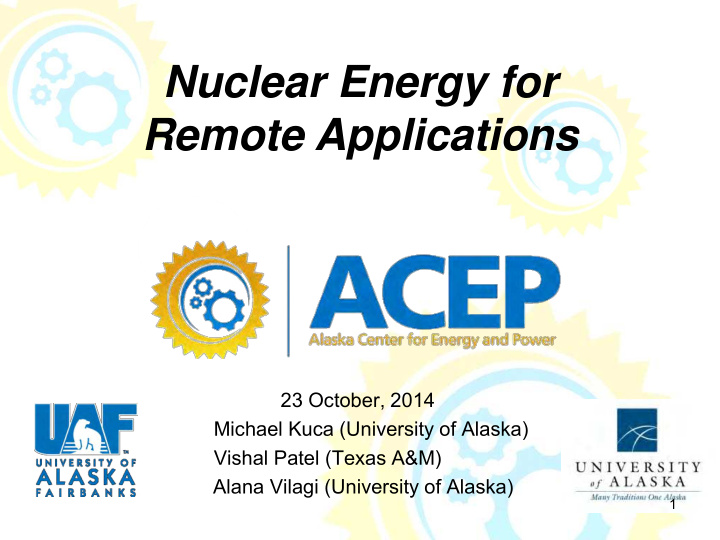



Nuclear Energy for Remote Applications 23 October, 2014 Michael Kuca (University of Alaska) Vishal Patel (Texas A&M) Alana Vilagi (University of Alaska) 1
Objectives Consider GenIII+/GenIV nuclear power plants ► for remote applications ACEP – INL/CSNR collaboration: ► POLAR design team Taylor Duffin (University of Utah) Michael Kuca (University of Alaska) Haley McIntyre (University of Alaska) Christopher Morrison (Rensselaer Polytechnic Institute) Vishal Patel (Texas A&M) Alana Vilagi (University of Alaska) Opportunities and Obstacles to deployment ► 2
Fuel Supply Chain; Consumer Costs AK utilities: $0.20 to $1.30 per kWh ► Remote fuel price:$5 to $10 per gallon ► ISER (2010) Alaska Dispatch (2012) 3
Technology: Big Picture INL (2013) 5
Technology: Small and Mini Gen III+ iPWR Gen IV reactors • Integrates steam generator • Alternative cooling designs into pressure vessel • Factory sealed, no refueling • Passive designs remove • Individual units compliment decay heat micro-grid • US Modular design compliments macro-grid Examples (MWe) Examples (MWe) Sodium Toshiba 4S – 10 NuScale - 45 mPower - 225 Pb-Bi G4M – 25 CAREM – 25 KLT-40S - 10 LFR SSTAR - 20 7
CSNR ACEP Collaboration CSNR: mini reactors for space exploration ► Some aspects apply to northern deployment • Design a mini Gen IV mobile reactor ► Parameters • o Safe o Transportable o Passive cooling, Non-pressurized vessel o Less than 10 MWe o Long life 8
POLAR Passively Operated Lead Arctic Reactor 15MWth/5MWe • PbBi cooled, natural circulation • Core Outlet Temp 550 °C • Open air Brayton Cycle 500 °C • Ship weight 100 ton • 9
POLAR Lifetimes at 5 MWe Case Approximate Lifetime (years) W-Cermet Fuel Loading 1 6 W-Cermet Fuel Loading 2 10 SiC Fuel 15 UZr Fuel 20 10
Process Heat Applications Application Temperature Range (Celsius) Fish Processing 30-50 Greenhouse 45-50 District Heating 30-80 Desalination 30-130 Biomass to Biofuels 200-500 Oil Production 500-600 Coal to liquid fuels 800-900 Hydrogen Production 800-1000 11
Process Heat Applications 0°C 1000°C 12
Licensing Issues for SMRs Deterministic focus on Light Water Reactors ► Staffing: 4 operators per shift for total 40-80 • Core Damage Frequency • Possible Strategies for Gen IV ► New Regulations – time consuming • Exemptions – complex • Risk-Informed Performance-Based Licensing • 13
Risk-Informed Performance- Based Licensing Preferred licensing strategy for the Next ► Generation Nuclear Plant project Review process that emphasizes outcomes ► rather than prescriptive methods for achieving them, providing more flexibility in design 14
NRC Licensing Timeline 15
Alaska Sustainable Energy Act 2010 Gave Legislature authority to designate land in state for ► nuclear facility based on economics Health and public safety NRC jurisdiction • The Department of Environmental Conservation shall ► adopt regulations governing the issuance of nuclear facility siting permits Authorization program has not been created • Require municipal approval ► 16
Conclusions • Remote nuclear power plants may be viable in 2020s • Continue UA R&D Partnerships • Lack of super utility; promote stakeholder alliance – Military, Civilian, Industry – Communicate with state and federal legislators • Licensing challenges are not insurmountable – Early site permitting – Siting facilitated through legislature • Initial capital investments – First of a kind funding – Master Limited Partnership 17
References Abdulla, A., Azevedo, I. L., & Morgan, M. (2013). Expert assessments of the cost of light water small modular reactors . Proceedings of the National Academy of Sciences of the United States of America, 110, 9686-9691. Buongiorno, J. (2001). Conceptual design of a lead-bismuth cooled fast reactor with in-vessel direct-contact steam generation. Cambridge, MA: Doctoral Thesis, Massachusetts Institute of Technology. Dostal, V., Hejzlar, P., Driscoll, M. (2006). Supercritical cabon dioxide power cycle: comparison to other advanced power cycles. Nuclear Technology, 154, 283-301. Ingersoll, et. al. (2004). Status of Preconceptual Design of the Advanced High-Temperature Reactor (AHTR). ORNL. International Atomic Energy Agency (2007). Status of Small Reactor Designs Without On-Site Refueling . IAEA-TECDOC-1536. Makhijani, A., & Boyd, M. (2010). Small modular reactors: No solution for the Cost, Safety, and Waste Problems of Nuclear Power. Washington, D.C.: Institute for Energy and Environmental Research and Physicians for Social Responsibility. Nuclear Energy Institute. (2010). NRC annual fee assessment for small reactors. Washington, D.C.: NEI. Nuclear Energy Agency. (2007). Handbook on lead-bismuth eutectic alloy and lead properties, materials compatibility, thermal-hydraulics and technologies., Danvers, MA.: OCED/NEA 18
References Nuclear Regulatory Commission (2012 ). Report to Congress Advanced Reactor Licensing. Nuclear Regulatory Commission. (2013). Summary Feedback on Four Key Licensing Issues Next Generation Nuclear Plant . Office of New Reactors. Ramana Rao, M.V., Sadasivudu, D. (1974). Pressure drop studies in helical coils. Indian J. Technology, 12, 473. Sabharawall, et. al. (2011). Feasibility study of secondary heat exchanger concepts of the advanced high temperature reactor . INL/EXT-11-23076 Solan, D., Black, G., Louis, M., Peterson, S., & Carter, L. (2010). Economic and employment impacts of small modular nuclear reactors. Idaho Falls, ID: Energy Policy Institute, Center for Advanced Energy Studies. Stewart, J., Lamont, A., Rothwell, G., Smith, C., Greenspan, E., Brown, N., & Barak, A. (2002). An economic analysis of Generation IV small modular reactors. Livermore, California: U.S. Department of Energy, Lawrence Livermore National Laboratory. The Economic Modeling Working Group of the Generation IV International Forum. (2007). Cost estimating guidelines for generation IV nuclear energy systems. Washington, D.C.: OCED Nuclear Energy Agency. Venneri, et. al. (2014). Design of a Tungsten CERMET LEU-NTR . ANS-NETS. Waltar, A., Todd, D., Tsvetkov, P. (2012). Fast Spectrum Reactors. 978-1-4419-9571-1. 19
Questions? 20
Recommend
More recommend